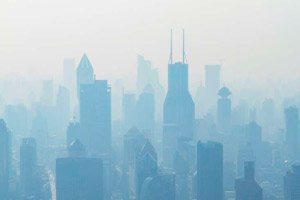
All iLive content is medically reviewed or fact checked to ensure as much factual accuracy as possible.
We have strict sourcing guidelines and only link to reputable media sites, academic research institutions and, whenever possible, medically peer reviewed studies. Note that the numbers in parentheses ([1], [2], etc.) are clickable links to these studies.
If you feel that any of our content is inaccurate, out-of-date, or otherwise questionable, please select it and press Ctrl + Enter.
New research links childhood air pollution exposure directly to bronchitis symptoms in adults
Last reviewed: 02.07.2025
 ">
">A new study has revealed fresh evidence about the link between early life exposure to air pollution and lung health later in life. A research team led by the Keck School of Medicine of the University of Southern California found that exposure to air pollution in childhood was directly linked to bronchitis symptoms in adulthood.
To date, many studies have established intuitive connections that are not direct: childhood exposure to air pollution is consistently associated with childhood lung problems, and childhood lung problems are associated with adult lung disease.
The current study, published in the American Journal of Respiratory and Critical Care Medicine, is one of the few to show a direct link between childhood air pollution exposure and adult lung health that is not fully explained by the effects of air pollution on lung health in childhood. This raises the possibility that there are as yet unexplored factors that explain the pathway from early air pollution exposure to respiratory disease many years later.
The team used data from the University of Southern California's Children's Health Study, a long-term study that follows cohorts of Southern California residents from school age through adulthood for many participants. Importantly, the association between childhood air pollution exposure and adult bronchitis symptoms persisted even when adjusting for asthma or bronchitis symptoms in early life — a result that came as a surprise.
"We expected that these observed effects on respiratory health in childhood would explain the association between childhood air pollution exposure and adult respiratory health," said senior study author Dr. Erica Garcia, an assistant professor of population sciences and public health at the Keck School of Medicine. "Our findings suggest that exposure to air pollution in childhood has more subtle effects on our respiratory systems that continue to impact us into adulthood."
Protecting lung health now and in the future
The focus on childhood exposure is motivated in part by the fact that children are particularly vulnerable to the effects of air pollution. Their respiratory and immune systems are still developing, and they breathe in more air relative to their body weight than adults.
Ultimately, the issue is twofold: the health of young people today and their health as adults. It is particularly important to note that among the study participants with recent bronchitis symptoms as adults, the average childhood exposure to a pollutant called nitrogen dioxide was well below the U.S. Environmental Protection Agency's annual standards — just over half the limit set in 1971, which remains in effect today.
"This study highlights the importance of reducing air pollution, especially during the critical period of childhood," Garcia said. "Because we can only take limited steps to control our exposure, the need to protect children from the adverse effects of air pollution is best addressed at the policy level."
Health and Air Pollution Research
The study population consisted of 1,308 participants in the Children's Health Study with an average age of 32 years at the time of adult assessment. The researchers asked about recent symptoms of bronchitis - whether they had bronchitis, chronic cough, congestion or mucus production unrelated to a cold. A quarter of the participants had experienced symptoms of bronchitis in the previous 12 months.
The presence of bronchitis symptoms was associated with exposure to two types of pollutants from birth to age 17. One type includes fine airborne particles such as dust, pollen, wildfire ash, industrial emissions, and vehicle exhaust products. The other is nitrogen dioxide, a combustion product in cars, planes, boats, and power plants that is known to have harmful effects on lung function.
Long-term health studies for significant discoveries
To provide the most comprehensive analysis, average childhood exposure to pollutants was based on monthly estimates. The researchers matched families’ home addresses at each point in time with contemporary local air quality measurements from the U.S. Environmental Protection Agency and the Children’s Health Study.
"We are fortunate to have this wonderful, detailed long-term study," Garcia said. "We can learn a lot about how early experiences affect adult health. This is thanks to the long-term efforts of the study participants, their families, the schools they attended, and all the research staff and investigators who conducted interviews and analyzed the data over many years."
Differences in the impact of air pollution
Garcia and her colleagues also found that the effect of childhood exposure to nitrogen dioxide and particulate matter on adult bronchitis symptoms was stronger in those who had been diagnosed with asthma as children.
"There may be a subgroup that is more sensitive to the effects of air pollution," Garcia said. "We need to be especially careful to protect them from exposure to improve their future outcomes. Reducing air pollution will benefit not only current asthma in children, but also their respiratory health as they grow older."
Garcia and her colleagues are continuing to study how levels of air pollution exposure at different ages influence breathing problems in adulthood. Other avenues for future research could include examining other markers of childhood and adult respiratory health, such as asthma control, or investigating a possible genetic component.
